| Return to Index |
At Longstaff Bluff, Baffin Island Circa. 1965.
During the year 1965, I was stationed on the
Distant Early Warning Line in Baffin Island. I went through all seasons there and
actually enjoyed many of the facets of life there. Some of the fascinating aspects of life
in the Arctic are: No one contracted the flu or a cold while there, some of the animals
were not afraid of humans, winter lasts from 15th of September to about early July,
and during the brief summer, there is a beautiful profusion of flowers and plant
life. Although the only trees were "Arctic Willow" that grow about three
inches high and then hug the ground. Due to the lack of trees, distances are difficult to
determine by sight. One can scan far more territory in the Arctic than down south,
so a one day walking trip should be planned with extreme prudence.
Once in a while, some Eskimos (now referred to as Inuit) would wander through on their way to somewhere. They
would trade some hastily carved bone or soapstone nic-nacs for some sugar, flour and
tea. These were usually 'hunting' parties and would often know some of our resident
Eskimos. Any visitors were welcome at our site so we always granted them their
requested rations. The nearest settlement was about 500 miles away. We often
took photos of their dogs and other objects as the developing equipment was provided
free by our employer.
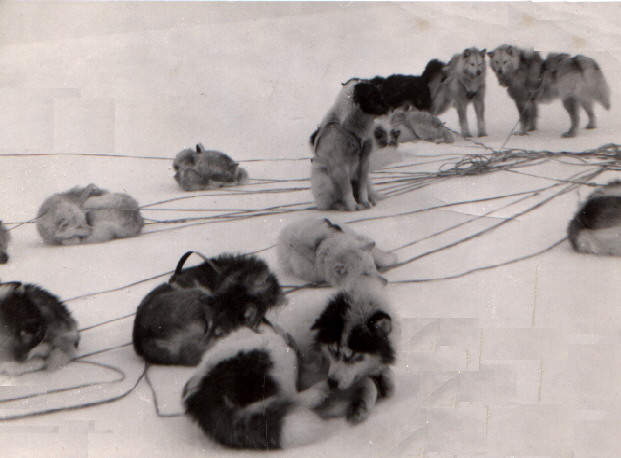
An eastern Arctic fan harness with Canadian Eskimo dogs resting in the
snow.
Can you spot 14 dogs in this photo?
Can you spot the ones that are part wolf?
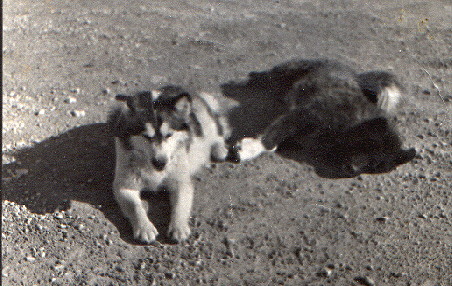
Two Canadian Eskimo dogs resting in the summer heat at Hall
Beach, NWT
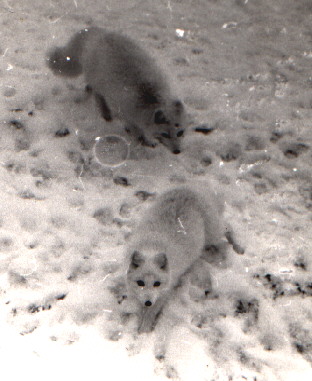
One day two Arctic foxes showed up and
indicated they were on the take for something good to eat. They were practically
tame and we were successful in enticing one into the module where we fed it some
goodies. It was not comfortable in the heat so we let it go back outside after
taking some photos to prove this story.
The Caribou were so tame that one actually began nibbling at my pants back pocket once,
when I was leaning over trying to open a lock on a shed. To shoot one of those lovely
creatures would have been unthinkable to any of us.
However, the Canadian Government ordered
us not to provide enough meat to our two on-site Eskimo families, so as to maintain
their hunting skills. Believe me, there was not much skill involved most of the
time. Once, I went on a Hare hunting trip with an Eskimo, and the Arctic Hare
actually stood there about twenty feet away and patiently waited for the Eskimo to adjust
his rifle sights with a rock, before finally dispatching the animal after several
shots.
I asked an Eskimo how they introduced wolf blood into their dogs, and one told me that
they would take a bitch in heat out on to the tundra and leave it there tied to a stake
with enough meat to last a week. When they retrieved the dog, and if it
was still alive, it was pregnant. If it was torn to pieces, a female wolf had
happened across it. The Eskimo outlook on life was far more fatalistic than ours and
a couple of their dogs were entirely expendable to gain some wolf blood in their
teams.
Pure wolf sled teams were useless as wolves didn't have the
necessary pulling strength, however some wolf blood was thought to improve the
overall stamina of the team. Sadly, during the 1970sand 1980s,the Eskimos took to
snowmobiles to the extent that most of the Sled Dogs were killed off. Today there
are very few left, and they are on the brink of extinction.
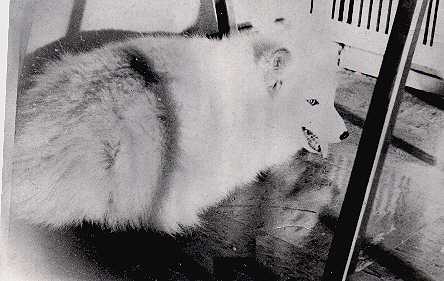
A wild Arctic fox resting under table in the dining module
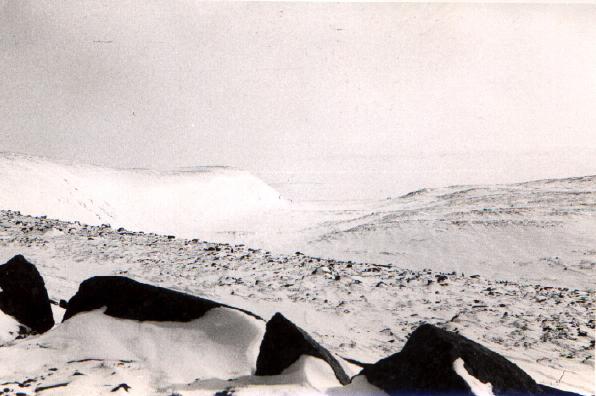
A typical snow swept treeless vista on Baffin Island